Skins (156)
Visuals (115)
Input Plug-ins (34)
Output Plug-ins (6)
General Plug-ins (14)
Archive Reader (15)
Input Plug-ins (41)
DSP Plug-ins (10)
External Add-ons (16)
XMPlay Archive (71)
Skins (156)
Visuals (115)
Input Plug-ins (34)
Output Plug-ins (6)
General Plug-ins (14)
Archive Reader (15)
Input Plug-ins (41)
DSP Plug-ins (10)
External Add-ons (16)
XMPlay Archive (71)
Welcome to the XMPlay Beginner's Guide! That you are here shows that you are interested in getting to know the world's most accurate module player.
This guide will take you through every step in XMPlays' "lifecycle" on a computer - from installation over everyday use and eventually to removal (which will hopefully not be neccessary).
If you are looking for more advanced guides, have a look at the Tutorials. If you cannot find what you are looking for, try the search function. If you still cannot find what you are looking for, please contact XMPlay Support - we will be happy to help you.
First of all, XMPlay is an audio player. It's a free piece of software that Ian Luck has written in his spare time back in 1998 and luckily continued development until today. You might have heard that XMPlay is the world's most accurate module player. That's right, but XMPlay is much more - it has grown into a fast, slim and beautiful multi-purpose audio tool that lets you manage your music library, listen to a wide variety of audio formats and even lets you save internet radio streams to disk.
Regarding audio quality, many users say that XMPlay just sounds better than a lot of other software out there, including Winamp and Foobar 2000, not to mention the most accurate module playback. That is because XMPlay does not use any of the MP3 decoding libraries that come pre-installed with Windows. XMPlay uses it's own routines to play MP3 and a lot of other formats which are supported right after you "install" XMPlay.
If you already have downloaded XMPlay, you can probably skip this part of the guide.
The primary download location for XMPlay is the Un4seen Developments website, which offers two mirrors for the latest binary. The other place where you can get a copy is the XMPlay Archive, which also offers all previously released versions for reference, bug hunting and nostalgia. The file name indicates which version you have downloaded. The downloads in the XMPlay Archive also contain minor version numbering for clarity.
First, you don't "install" it - you just extract the .zip file. No need for installation routines.
The recommended location for XMPlay is "C:\Program Files\XMPlay\", although you may extract it anywhere you like. After you're done, XMPlay is ready to use.
When you first start XMPlay, you will be greeted by the ReadMe and a dialog box telling you to "RTFM". After you close these, you will see something similar to this:

"What are these things at the sides and how do I disable them?" might be your first question. The answer to this is: these are the side panels and you can slide them in and out by dragging them at the "handles" at their sides, like this:
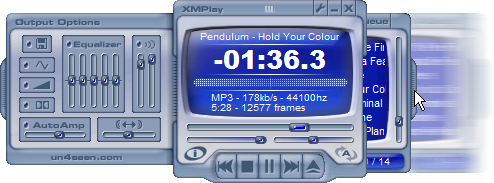
For now, let's concentrate on the main panel, which provides everything you need to open and play a file. For this, I closed both side panels - these will be discussed next.
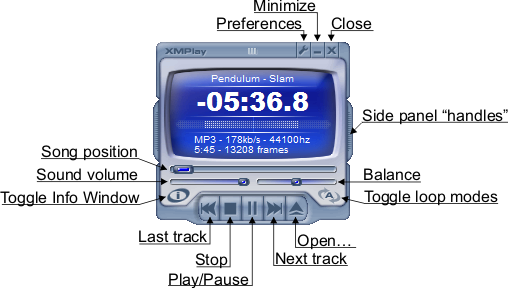
![]()
Options and stuff
This button opens up the Preferences for all areas of XMPlay, including settings that can only be found here. The Preferences can also be opened by right clicking anywhere on the Main Interface.
Minimize
Left clicking this will minimize XMPlay normally, while right clicking the minimize button will place XMPlay into the system tray. This will not have any effect if the "Always in tray" option has been enabled in the preferences.
Tip: The default Shortcut "N" minimises XMPlay normal, where "Shift+N" will minimize XMPlay to the system tray.
Close
Title
The title of the current track is displayed at the top.
Tip: A mouse over of this area causes a help bubble to appear if the track name is too large to display.
Timer
By left clicking on the timer it can be switched between the time passed, the time remaining, or the order/frame/page position (depending on if it's a MOD/MPEG/OGG format being played). When displaying the MOD position, the bpm/speed is shown to the right and the active channel count is shown to the left. The active channel count will be inverted if any virtual channels have been killed within the last few seconds.
Volume Indicator
This area provides a simple realtime display of the volume level in the left and right speakers.
File Information
At the bottom of this area some basic information on the format and length of the current track is displayed.
Tip: A "XM?" displayed during the play of an XM module means the mod was not created using Fast Tracker 2, and slightly changes the way the mod is played.

Position
The top most bar is the position indicator. It can also be used to change the playback position, except when streaming from the internet. When streaming from the net, it will light-up to indicate how much of the file has been downloaded so far.
Right-clicking the position bar allows you to set a bookmark or resume from one. See resuming playback for more info.
Tip: While streaming the position will only be shown if the file is of a fixed length.
Volume
This controls the volume of the output from XMPlay.
Balance
This slider controls the balance of output to the left and right speakers.
Track Info & Extended Playlist
This button displays details information on the current track and the extended resizable playlist. Check the Info Window for further details.
Loop Track
The looping for each individual track is controlled here. By left clicking it can be cycled through the available options of Never loop, Always loop, or Auto loop only files that are intended to be looped.
By right clicking this button you may access further options to restrict Auto Loop detection to only MOD's, and forcing XMPlay to only loop this track once before continuing.
Tip: These options can also be accessed via the "Miscellaneous Options" area of the preferences.
![]()
Previous Track
Play the previous track in the playlist, skipping over any that are set to be "skip"-ped in the playlist.
Tip: Right clicking on this allows navigation between songs while playing multi-song modules.
Stop
Stops playback, and sets the position to the start.
Tip: Pressing stop while already stopped will unload the current song (Eg. So the file can be moved or renamed.)
Play / Pause
Toggles play/pause of the track. If no track is loaded, then the currently selected track in the playlist is loaded (or the 1st track if none is selected).
Tip: Right-Clicking on this will play a randomly selected song.
Next Track
Play the next track in the playlist, skipping over any that are set to be "skip"-ped in the playlist.
Tip: Right clicking on this allows navigation between songs while playing multi-song modules.
Open file(s)
Opens and plays file(s). If you open an FTP directory URL, XMPlay will automatically scan the directory for OGG and MPEG files.
Tip: Entire directories can be added via the playlist panel.
Any currently playing track can be resumed from any point even if XMPlay has been closed during play. To do this while a track is playing, simply right click on the Close button of XMPlay.
This will save the details of the position. When XMPlay is next started, play will automatically continue from the saved point.
Another way of resuming playback is using the bookmark function, which can be accessed by right-clicking the position slider. When you set a bookmark, XMPlay remembers the file and playing position and lets you return to the exact same position later ("Resume bookmark"). You can only set one bookmark at a time.
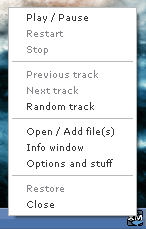
![]()
While XMPlay is minimized here, every track change will be shown via a help bubble that appears above the system tray area, showing the new track.
By using the right click menu you can access most of the same functionality that is available through the main panel.
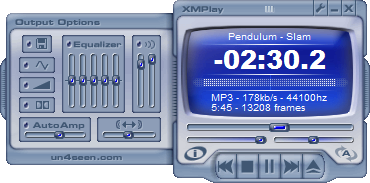
The response speed to all these options is dependant on the buffer size, the delay will be the length of the buffer chosen in the Device section of the Options and stuff window.
Tip: These options only effect the playback of MOD file formats (MO3/XM/IT/etc) and can also be found under the MOD section of the Options and stuff window.
![]() Linear
Linear
![]() Sinc
Sinc
Linear 2 point interpolation "draws" a straight line between the samples, Sinc 8 point interpolation "draws" a smooth curve between the samples and requires more CPU power (Supports 3DNow! Technology.).
Linear interpolation gives decent sound quality with minimal cpu usage.
Sinc interpolation has, as a result of its complexity, far higher sound quality, with the price of higher cpu usage.
Interpolation can also be disabled. This is useful for older module to provide a crisper sound.
![]() Normal
Normal
![]() Sensitive
Sensitive
Ramping makes volume and panning changes smoother so that sudden large volume/panning changes do not cause any "clicking" in the sound.
It also fades-in (very quickly) new samples so that there is no click from them.
Sensitive ramping only performs the fade-in when it's neccessary to prevent a click, so percussive sounds stay sharp.
![]() "Normal" surround adds a phased surround sound feeling to modules.
"Normal" surround adds a phased surround sound feeling to modules.
![]() "Mode 2" ignores panning, so is good for mono MODs.
"Mode 2" ignores panning, so is good for mono MODs.
The higher the setting, the more sounds are pushed away from center. Obviously can only affect things when playing in stereo.
Tip: These options can also be found under the DSP section of the Options and stuff window.
![]() Normal
Normal
![]() Fade-In
Fade-In
![]() Dynamic
Dynamic
This is different to the volume slider. The volume slider controls the level of the sound card output, the amplification slider controls the level of the actual decoding.
The higher the amplification, the greater the dynamic range of the decoding output, but if it's too high clipping may occur resulting in distortion of the sound. Right-click options:

"Default" sets the amplification level back to its default amount (0.0 db).
"Reset on new track" resets the amp level when a track is loaded.
This causes the amplification level to be automatically reduced whenever clipping occurs. With fade-in enabled, it will fade-in new tracks until they clip, then it'll behave the same as normal. Dynamic mode continues to increase and decrease the amplification level throughout playback.

![]()
These are two built-in DSP settings that are available by default to improve the sound quality. The equalizer comes with some presets which may be selected by right-clicking the Equalizer button. The left reverb slider controls the frequency cutoff, i.e. the crispness of the reverb sound. The right slider controls the reverb level. Note that the reverb length is currently not adjustable.
When switched on, this enables the automatic loading of settings that have been saved for the track being loaded. Right-clicking brings up options to load settings specific to the file, load settings for the file's path, and load presets.
Tip: Advanced settings and further information can be found in the Saved settings section of the Options and stuff window.

Besides the obvious functionality of playing a list of files, the XMPlay playlist has some other neat features, like the Queue and "Dragon Droppings", which will be explained later. First, let's look at the basic functionality.
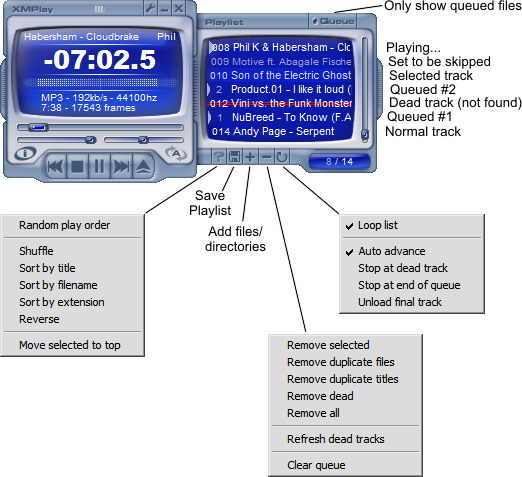
Select a track by clicking on it.
Doubleclicking plays a track.
Hold Ctrl to select multiple files at once.
Hold Shift to select ranges of files, just as in Windows Explorer.
Use Ctrl+Shift to select multiple ranges of files.
You can drag files around the playlist to change their playing order.
Tip: "Dead" tracks will be marked with a double red line. Merely unplayable files will only be marked with a single red line.
The context menu of any file will give you a list of options:
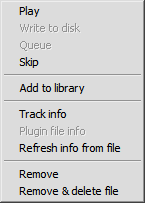
Dropping files on the main window will make them replace the current playlist and begin playing immediately.
Dropping files inside the playlist will insert the files above the track that you dopped the files upon.
Dropping files on the "Add tracks" button will add the files at the bottom of the playlist.
XMPlay supports the reverse of "Drag and Drop": dragging a file out of the playlist and into other applications that accept Drag and Drop actions.
To do this, select one or more tracks on the playlist, begin dragging with the left mouse button and then press the right mouse button. The cursor will now indicate valid targets for external Drag and Drop operations.
If you drop files in file managers, XMPlay will copy them there. If you drop files on other applications, e.g. for opening files, XMPlay just passes a reference to the actual file to the other application.
This works from both the playlist panel as well as the "big" Playlist.
You can enable/disable random playing here. Right-clicking gives you more options:
Tip: only tracks that are currently selected will be sorted.
Saves the playlist as Unicode .pls file.
Left-clicking the plus button opens a dialog where you can select one or more files to be added to the playlist.
Right-clicking the plus button opens another dialog, where you can add whole directories and subdirectories at once.
Tip: drag'n drop files or directories here to add them to the bottom of the playlist rather than inserting them inbetween.
Left-clicking the minus button removes the selected tracks from the list.
Right-clicking the minus button gives you these options:
Tip: use "Refresh dead tracks" to revive tracks that were not found because they reside on removable media, like a USB harddrive.
Left-clicking toggles list looping. This option does not influence the track looping option. When list looping is active, playback will begin on the first track after the last track has played.
Right-clicking the button gives you these options:
The small display on the bottom right can be switched between two modes:
Time mode - This shows the total playlist duration in hours, minutes and seconds. If you have tracks selected, the display will flash between the total duration and the duration of the selected tracks.
Tip: The alternating flashing between the times can be disabled by adding the line "NoFlashTotal = 1" to the xmplay.ini. See "Secret INI options" for more options.
Track count - shows the currently playing track and the total number of tracks on the playlist.
If you want the playlist to leave out a certain track while playing, you can mark the track to be skipped via the context menu item "skip" or by pressing the default shortcut "Space". Un-skipping works the same.
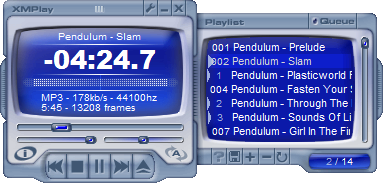
Queueing tracks allows files to be played in a different order than the playlist dictates. Just click the tracks with the middle mouse button in the order you want them to be played. (Note: The currently playing song can't be queued.)
Alternatively, you can right-click one or more files and select "Queue".
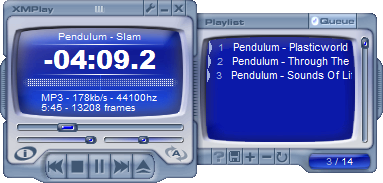
If you press the "Queue" button on the upper right of the playlist panel, the playlist will show queued tracks ONLY.
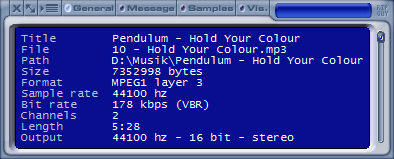
The Info window provides access to a bigger, resizable playlist, detailed track information, the media library, visualisations and more.
You can resize the window by dragging one of it's edges with the mouse. The Window also offers a mode to auto-resize itself to fit the contents (![]() ).
).
![]() This switch toggles between displaying the Information Section and the Extended Playlist.
The Information Section displays information on the currently loaded track, while the Extended Playlist is a large and more flexible version of the one available in the Playlist Panel.
This switch toggles between displaying the Information Section and the Extended Playlist.
The Information Section displays information on the currently loaded track, while the Extended Playlist is a large and more flexible version of the one available in the Playlist Panel.
Tip: The Information Window can also be open even while XMPlay is minimized to the System Tray.
Displays info on the file's name, format, size, length, etc...
Displays any messages or tags contained in the file, including the current track name when streaming from Shoutcast servers. Also displays single tracks from a CUE sheet, if one was found for the current track. See CUE Sheet Usage for more information.
Tip: Right-clicking gives the option to copy the window's text to the clipboard, and also launch any URL's available.
Displays instrument and sample texts (MOD formats only).
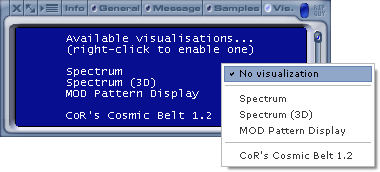
Displays visualisation plugins.
The Visuals Panel displays the currently available visual plugins, including the in-built Pattern and Spectrum Display's.
Once a Sonique visual plugin is installed, it will be listed here and may be selected by clicking the right mouse button within the Panel area or rolling up or down using the mouse scroll wheel.
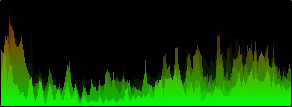
A spectrum analyser will give you a graphical representation of a certain frequency range.
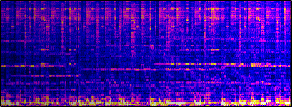
A 3D spectrum analyser will give you a graphical representation of a certain frequency range at a certain time and magnitude. This is shown by providing the time (horizontally), frequency (vertically), and magnitude (colour) of sound.
The "MOD Pattern Display" visualisation applies to MOD formats only, and allows you to get an idea of how the files were "tracked". For simplicity and clarity, not all effects are shown and a universal notation is used for all formats.
When all the channels do not fit in the display, the 4 & 6 (numpad) keys can be used to scroll the display. The selected channel can also be muted using the 5 (numpad) key.
XMPlay can use 2 alternate scrolling methods, which are changed by clicking on the Pattern Display with the middle mouse button, or via the "S" shortcut key.
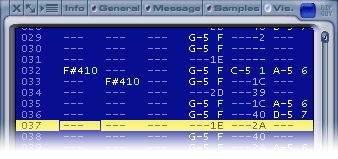
The following entries are shown by XMPlay:
Tip: This section only displays the features that are not contained in The Playlist Panel, for details about the basic playlist functions see the Playlist Panel section.
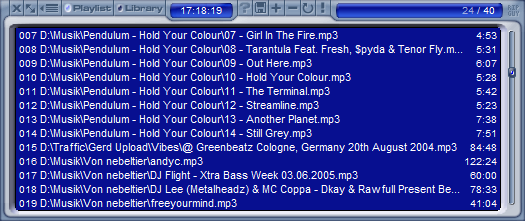
This button switches the playlist over to display the Library.
Find tracks containing a specified substring in their title or filename. Right-clicking allows you to choose to have only the matched tracks played (the rest will be skipped).
For details of how the this function works, see the Find Tracks section of the Options and stuff window.
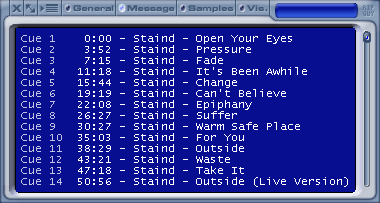
CUE files can be used to quickly jump to specific points (eg. start of a song in an album) in large files. When opening a track, XMPlay will look for a CUE file of the same filename (with ".CUE" extension) in the same directory or archive.
If one is found, it'll be loaded and the CUEs will be listed in the "Message" info window.
Tip: Right-clicking on the next and previous buttons will navigate through the CUE sheet.
For example the following files in an archive or directory would enable XMPlay to use a CUE sheet:
Staind - Break the cycle.flac
Staind - Break the cycle.cue
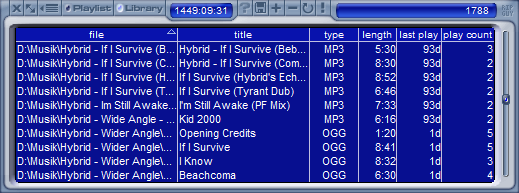
The library is a sort of glorified playlist. Whereas the playlist just contains each track's filename and title, the library contains a lot of additional information.
Files can be added to the library in the same way as they can with the playlist, eg. using the add button or by drag'n'dropping them. They can also be added automatically when played or added to the playlist. See the "Playlist" options.
Right-clicking on a track will give options to play the track, add it to the playlist, view/edit track info, refresh the info, and remove the track. Double-clicking will also play the track, and middle-clicking will queue the track.
Tip: When playing or queuing a track from the library, it'll first be added to the playlist if it's not already in there.
The full list of info contained in the library is: filename, title, artist, album, year, track, genre, comment, file type, file size, length, the time of last playback and the play count.
Each of which can be hidden or shown by right-clicking on a column heading.
You can also change the display order of the columns by dragging them, and you can change the width of each column by dragging the borders.
The tracks in the library can be sorted by any of these values, making it quick and easy to locate the tracks you want to play. Click on the column heading to sort by that value. Clicking again will reverse the order.
XMPlay can currently load the following add-ons:
All add-ons reside in their own sub-directories under the directory where you installed XMPlay.
Probably you will have your plugin/skin/vis as a .zip package, so you just have to extract them like this:
Note: Actually, you can put any plug-in, visual or skin anywhere into the XMPlay directory or into subdirectories - XMPlay will find them. It's just easier to maintain your XMPlay folder if you use the proposed subdirectory structure.
Some plugins are contained inside an installer (.exe), which will do the work for you.
Alternatively, you can do this:
Some visuals have additional functions and/or options that are accessible via the middle mouse button.
After you have extracted the plugins into their directory, you might want to configure them. This is how you do it:
If you need to remove a skin, plugin or visual, just locate the corresponding .dll (plugin), .svp (visual) or .xmpskin (skin) file - and simply delete it.
Note that moving a file from one subdirectory of XMPlay to another does not prevent it from loading! On startup, XMPlay looks for loadable files in all subdirectories, so you have to delete a file or move it outside of the XMPlay directory to prevent XMPlay from loading it.
In this chapter, all available options of XMPlay will be explained in-depth.
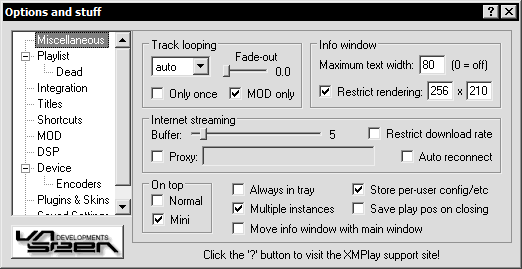
The track looping options are as follows:
Tip: Auto-looping may cause unwanted behaviour if you frequently listen to DJ sets or albums in which songs fade into each other. In this case, enable the option "MOD only".
The maximum text width sets the number of characters that will be in the Info Window before wrapping to the next line.
Restrict rendering applies to the Vis window - some Visuals behave strangely or even crash XMPlay if they are displayed at resolutions higher than 256 x 210, which was the fixed size of Sonique's Vis window.
Here you can set, at which modes XMPlay will appear in front of all other windows.
Tip: Even if you have "Move info window with main window" enabled or disabled, you can invoke the opposite behaviour "on the fly": while dragging one of the windows around, click the right mouse button. The other window will now be detached or attached respectively.
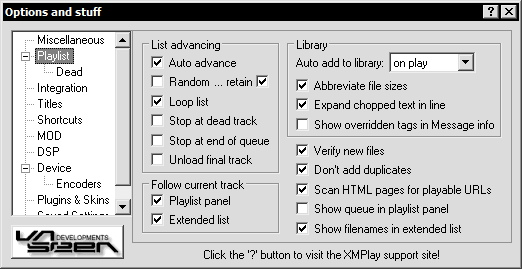
This option makes the selected playlists auto-scroll to center the currently playing track.
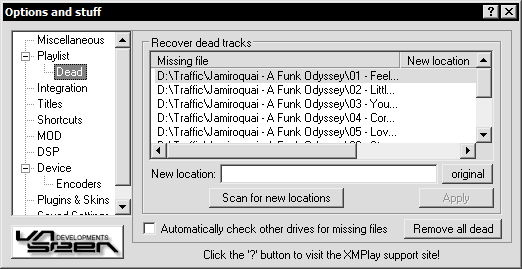
If XMPlay encounters any file that it can't find, it will be displayed here. You can then enter a new location for every file by hand, or let XMPlay scan for new locations.
Pressing the "original" button will enter the filename of the dead files into the editing field next to it, so you can change the directory more easily if you just moved the file.
If you frequently use removable drives which contain your music, XMPlay might mark tracks as dead which are on one of these drives. Ticking the "Automatically check other drives for missing files" option will make XMPlay search on removable drives (CD, DVD, USB/Firewire devices) as well. The "Remove all dead" button removes all dead tracks from the playlist or library.
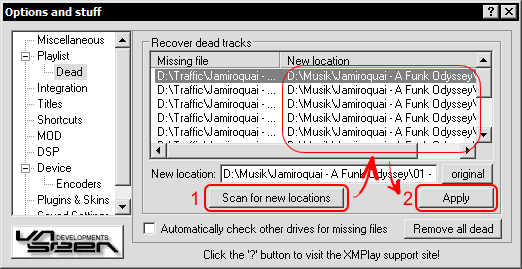
First, press the "Scan for new locations" button. A dialog will pop up where you can select a directory to scan in. Enabling the "Subdirectories" option on that dialog will scan in subdirectories as well, increasing your chance of finding the missing files. After XMPlay finishes it's search (and the files are found), click the Apply button.
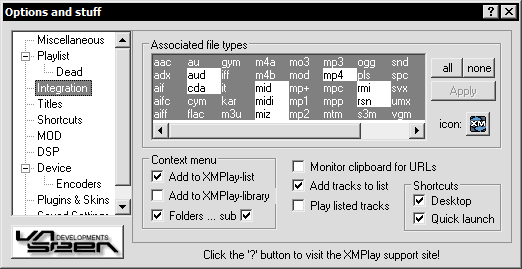
Selecting an extension in this list will set XMPlay as default player for this filetype. The buttons on the side let you select either all or no extensions. After you're done selecting, press Apply.
You can also select an icon that will be used to display all files that are associated with XMPlay.
Here you can select where you want to have shortcuts to XMPlay. Enable to add a shortcut, disable to remove it.
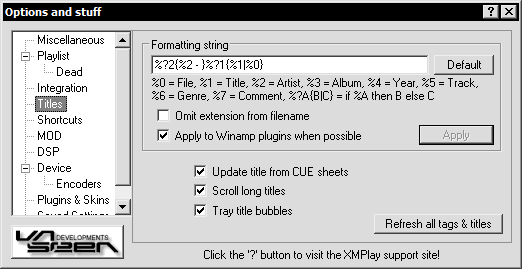
Formatting string
This string works similar to a regular expression (which you will be familiar with if you are a programmer). Some formats don't have tags, eg. MOD formats just have a title "tag". This could make the titles messy when elements are not available, if it wasn't for the fact that the formatting can vary depending on what tags are available.
For example, the default formatting is: %?2{%2 - }%?1{%1|%0}
This means if the artist tag (%2) is present, use that and place " - " after it. Then, if the title tag (%1) is present, add that, otherwise add the filename (%0).
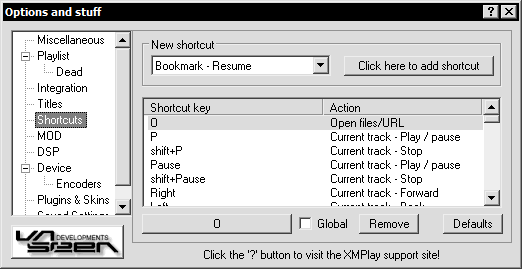
Here you can fully customize how you control XMPlay via the keyboard.
Multiple keys can be assinged to perform the same action, likewise multiple actions can be assigned to a single key. When multiple actions are assigned to a single key, they are performed in the order that they were added.
As an example, you could assign a key to select all search matches, invert the selection, and delete selected tracks. That'd leave you with just the search matches left in the list.
Tip: When changing the volume/amplification/EQ/reverb through shortcuts, a help bubble will appear on the mouse pointer to indicate the new value.
A list of all default shortcuts can be found here.
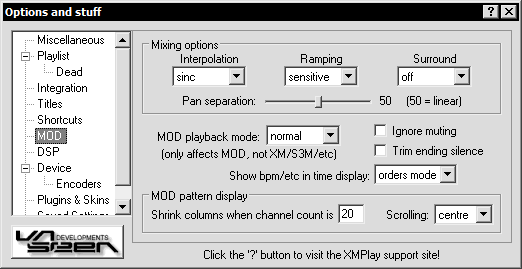
These options only affect MOD file formats (MO3/XM/IT/etc).
MOD playback - decides how MOD files should be played.
Here's what the other options do:
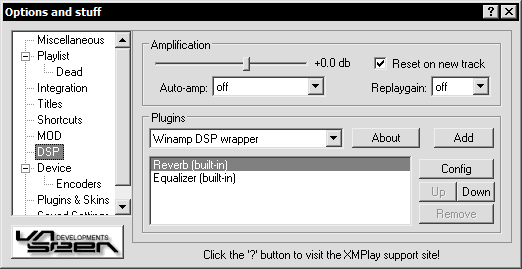
The response speed to all these options is dependant on the buffer size, the delay will be the length of the buffer chosen in the device setup.
The bottom part of the window is dedicated to DSP plugins. The "up" and "down" buttons can be used to change the order in which the DSP are applied. This DSP list also allows for multiple DSPs to be active at once, in whatever order the user chooses. There are 2 built in DSPs - the equalizer and reverb. Most Winamp DSP plugins can be used via the "Winamp DSP wrapper". You can create your own plugins by using the SDK available from the XMPlay website.
Once a DSP plugin has been installed it then has to be setup within XMPlay. In this example we will be setting up the iZotope Ozone DSP.
Once installation is complete, start XMPlay and proceed to the Options dialog. Under the DSP option you will find the Winamp DSP wrapper listed, press Add and double click the new "Winamp DSP wrapper - no plugin" entry.
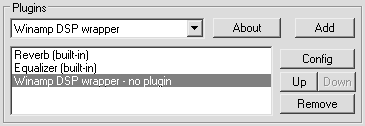
The DSP wrapper's config will appear, once the iZotope Ozone plugin is selected Ozone's Dialog will appear, and may be enabled to process audio via the check box in the same dialog.
Tip: Most DSP plugins need the Resolution left at 16 bit. It is also recommended that you are not playing music during the DSP setup.
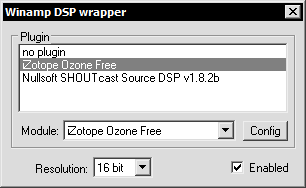
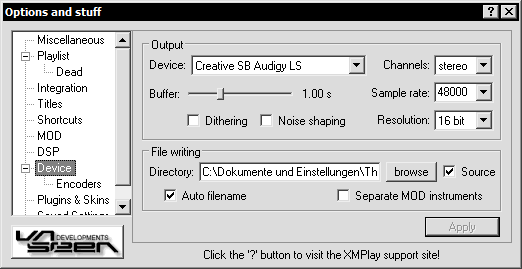
You can change which device (if you have multiple devices) to use, and what frequency, resolution, channels and buffer to use with the device. If the chosen device is not available then a free device will automatically be used instead, if there is one available.
You may also choose the "WAV Writer" device, to write the output to WAV files rather than a soundcard. External encoders ("External - ?") can also be used to write compressed audio files, eg. MP3 or OGG. See the next part: "setting up external decoders" for details.
The amplification slider on the "DSP" section controls the volume level of the WAV. Be careful not to use a too high amplification level as this may result in samples being clipped. You can avoid any amplification problems by using the "WAV Writer - normalized" device.
If the device does not support the settings you chose, XMPlay will use the closest settings that the device does support. When a track's sample rate is not supported by the device, XMPlay will automatically down-sample it to a rate that is supported.
Tip: If looping is enabled while using a writer device, the track will be looped only once in the written file, even if the "Only once" switch is not on. The sample rate option only affects MOD formats. See the "Output" text in the "General" info window for the exact format of the output.
From here you can select the default destination when using a WAV Writer, or External Device. Dithering and noise-shaping are recommended when writing to disk (eg. to burn on CD), but noise shaping is not recommenced if you intend to process the written file (whenever possible, use 32-bit instead).
Tip: When writing to disk (including external encoder), 32-bit is standard IEEE754 floating-point ("type 3" WAV).
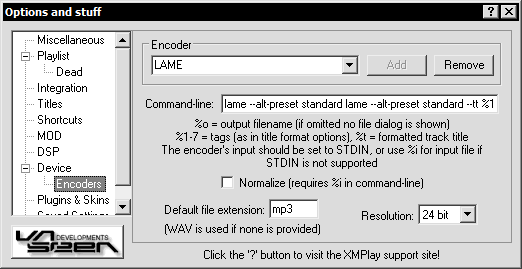
Here you can add/remove/edit the encoders available to the device list.
Any command-line encoder can be used, optionally using STDIN, so that no intermediate file writing is required. The resolution of the sample data sent to the encoder will be as set in the "Device" options above, unless it is overriden here. Settings for the LAME and OGGENC encoders are provided, to use them put the LAME.EXE or OGGENC.EXE file in the same directory as XMPlay.
Tip: Normalization requires the %i source tag in the encoder command-line.
Once an encoder has been installed it must be configured. This is done by adding a command to XMPlay so it knows were and how to send the information, as well as settings on how to encode the file.
First enter the name for the encoder you are installing, this name is up to you. For example in this screenshot I have chosen LAME as the name, we then click the add button.

This command line is all that needs to be added, and is different for every encoder. To make this easier, examples of the command line and what each part means has been listed in the Encoders Settings section. Information about an individual encoder's commandline can usually be found in contained with the encoder as a txt file or in the encoder itself. Simple double clicking on the encoder in windows explorer will give a description with most encoders.
![]()
Don't forget to enter the extension of the encoded file. In this case "mp3" is the correct extension for this filetype. The "wav" extension will be used by default if this field is left empty.
![]()
This section also allows you to specify the resolution of the audio for each encoder instead of just accepting the current resolution selected.
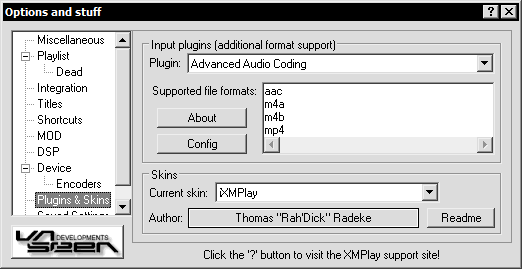
Here you can see which input plugins you have installed and which formats they support.
Clicking the "About" button brings up a dialog box with information over the current plugin.
Pressing the "Config" button brings up the plugin-specific configuration dialog, if it has one.
Here you have a list of currently installed skins. Selecting a skin loads it.
Clicking the "Author" button takes you to the skin author's website, if specified.
The "Readme" button brings up additional information about the skin, if the author has provided some.
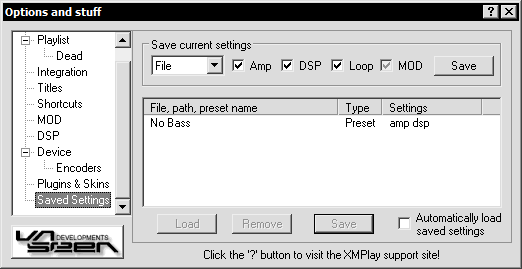
Amp/DSP/looping/MOD options can be saved, to be automatically applied when specific tracks are loaded, or saved as presets to be quickly set whenever wanted.
When saving settings, the settings that are actually saved is determined by the check boxes. The "MOD" box can have a greyed tick, which means that the MOD settings are only saved if the current track is a MOD format.
Tip: To save a default setting for all tracks, save your settings as a path and edit the path to "".
Before clicking "Save", you need to select what the settings will apply to. There are 3 types of saved settings - "File", "Path", "Preset".
The preset name or file/path of a saved settings can be edited by clicking on the entry in the list.
Path - This will save the settings to be used by all songs in the path of the current track.
There is also no specific "default" setting, but a "" path setting can be used instead, as that will match all files.
Preset - This allows you to save a preset which can be loaded for any track at any time.
The saved settings can be accessed by right clicking the settings button (disk icon) in the Output Options panel.
When XMPlay tries to load settings for a track, it will first look for a "File" match. If there is none, it will look for a "Path" match. In the case of there being multiple path matches, the longest match will be used.
For example, both "c:\" and "c:\blah\" match "c:\blah\blob.mod", but the "c:\blah\" settings will be used.
If you encounter problems with a plugin, vis or skin and want to get rid of it, simply delete the corresponding file.
If you just need to remove the offending object for testing or development purpose, you have to move the file outside of the XMPlay directory. If you place a plugin, skin or vis anywhere inside the XMPlay directory, XMPlay will attempt to load it.
If you need to remove XMPlay, for whatever reason, simply do the same as with plugins, etc.: delete it. You can safely delete the whole XMPlay directory - it will leave no trace in the registry.
If you had associated one or more files with XMPlay, it is recommended to un-associate them BEFORE you delete XMPlay. Do this at the Integration options.
Tip: If you had "Store per-user config/etc." enabled, you need to locate and remove the XMPlay folder in your "Documents and Settings" directory, too.